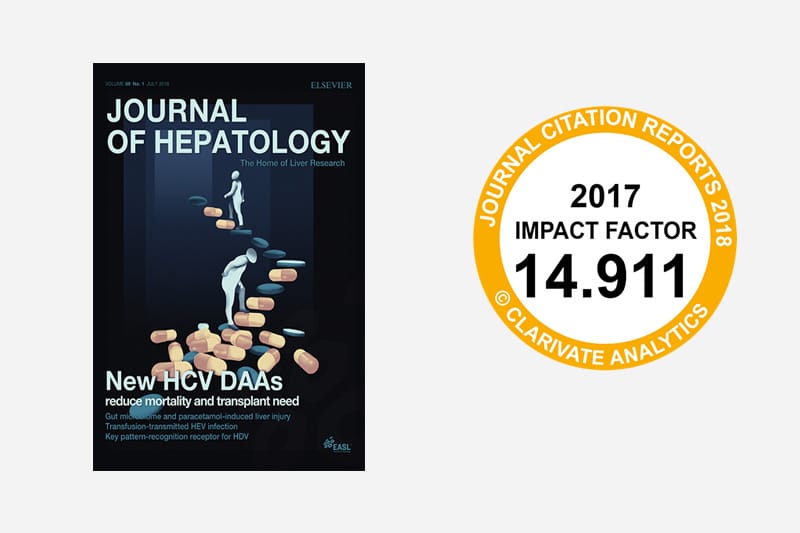Journal of Hepatology cited over 37,000 times in 2017

GENEVA, Switzerland 02 July 2018 – Last week Clarivate Analytics released the 2018 update of its Journal Citation Reports©, including the much anticipated 2017 impact factor. The Journal of Hepatology achieved exceptional results with a 2017 impact factor of 14.911, up from the 2016 score of 12.486. The Journal of Hepatology was cited 37,108 times in 2017, making it the fourth most highly cited journal in the field of Gastroenterology and Hepatology.
The ranking also reveals that the Journal of Hepatology continues to surge ahead with an impressive 19% increase in one year. To date, the 2017 score is the highest the Journal of Hepatology has achieved.
“I am delighted to see that the Journal of Hepatology has attained 1st position amongst the specialist Hepatology Journals, increasing its impact factor by 19% to 14.911. It is the highest impact factor the Journal has had since it was founded over 30-years ago. This unprecedented success is due to the clinicians and scientists who publish their best papers in the Journal and I take this opportunity to thank them for trusting us with their work. I acknowledge the efforts of the whole Editorial team, the Journal office and the EASL Governing Board whose incredible energy, guidance and support has allowed us to reach this amazing milestone” said Prof. Rajiv Jalan, Editor-in-Chief of the Journal of Hepatology.
The record high score reaffirms the continued commitment of EASL, The Home of Hepatology™ to provide the scientific community with a high-quality publication that delivers impactful content as the Home of Liver Research.
“The EASL Governing Board congratulates the Editorial team, the Editorial board, and the Journal office on the great success of achieving the highest impact factor ever for the Journal of Hepatology. The Journal of Hepatology is an EASL flagship, and thanks to the hard work of Rajiv Jalan, as well as all the previous Editors-in-Chief, the journal of our society has now found itself a stable position in the top tier of academic publishing,” said Prof. Tom Hemming-Karlsen, Secretary General of EASL.
An impact factor is a measure of a journal’s significance in an academic field. It considers the frequency with which the average article in a journal is cited in a given year. This data helps indicate a journal’s relative importance when compared to other publications in the same field. The Journal of Hepatology publishes 12 issues a year and covers a wide variety of topics in clinical and basic research within the field.
###
About the Journal of Hepatology
The Journal of Hepatology is the official journal of the European Association for the Study of the Liver (EASL). It publishes original papers, reviews, case reports, and letters to the Editor concerned with clinical and basic research in the field of hepatology. http://www.journal-of-hepatology.eu
About EASL – The Home of Hepatology
In the fifty plus years since EASL was founded, it has grown from a small organization that played host to 70 participants at its first meeting, to becoming the leading liver association in Europe. EASL attracts the foremost hepatology experts as members and has an impressive track record in promoting research in liver disease, supporting wider education, and promoting changes in European liver policy. https://www.easl.eu
Clarivate Analytics
Clarivate™ Analytics accelerates the pace of innovation by providing trusted insights and analytics to customers around the world, enabling them to discover, protect and commercialize new ideas faster. Formerly the Intellectual Property and Science business of Thomson Reuters, we own and operate a collection of leading subscription-based businesses focused on scientific and academic research, patent analytics and regulatory standards, pharmaceutical and biotech intelligence, trademark protection, domain brand protection and intellectual property management. Clarivate™ Analytics is now an independent company with over 4,000 employees, operating in more than 100 countries and owns well-known brands that include Web of Science™, Cortellis™, Derwent™, CompuMark™, MarkMonitor® and Techstreet™, among others. For more information, please visit clarivate.com.

